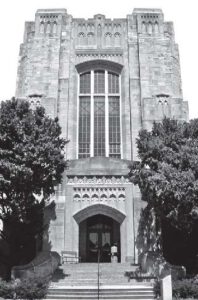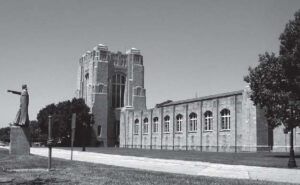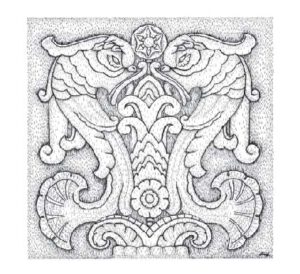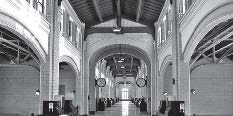The Three Rivers Water Filtration Plant was constructed at the confluence of Fort Wayne’s three rivers in 1933. When it was built, it had the capacity to produce 24 million gallons of treated water per day (MGD). Since the original construction there have been two major additions: a 24 MGD expansion in 1955 and a 24 MGD addition in 1981. The total capacity of the Plant today is 72 million gallons per day, enough to supply the needs of Fort Wayne for at least the next 10 to 15 years.
Learn more about how the Three Rivers Water Filtration Plant  cleans and treats drinking water for more than 300,000 people in the Fort Wayne region.
cleans and treats drinking water for more than 300,000 people in the Fort Wayne region.
No municipal improvement in the history of Fort Wayne has combined utility and beauty in such a marked degree as has the filtration plant. The public appreciation of it will grow with the coming years and it will remain a glorious monument to the courage and vision of its builders.
Frank Roberts, Editor Journal-Gazette, December 1933
History and Architecture of the Filtration Plant
The Filtration Plant was designed in the Collegiate Gothic architectural style.
Marrying Form and Function
 Fort Wayne’s Three Rivers Water Filtration Plant stands at the confluence of the St. Mary’s and St. Joseph Rivers where they meet to form the Maumee River. The Plant is, literally, a monument to the wisdom and vision of civic leaders, engineers and architects who remain committed to making the building both attractive and functional.
Fort Wayne’s Three Rivers Water Filtration Plant stands at the confluence of the St. Mary’s and St. Joseph Rivers where they meet to form the Maumee River. The Plant is, literally, a monument to the wisdom and vision of civic leaders, engineers and architects who remain committed to making the building both attractive and functional.
The 25 acre site east of Spy Run Avenue and at the confluence of the three rivers was chosen as the location for the Filtration Plant for several reasons. The land was already owned by the City and had been intended to be developed as Three Rivers Park. The central location was ideal for sending water to all parts of the City and the site, because of its natural sett ing, could be landscaped and made attractive. In a souvenir brochure distributed at the 1933 dedication Victor A. Matteson, a Chicago architect employed at the fi rm of Graham, Anderson, Probst and White, noted: “Surely no more beautiful spot could be wished for than the Three Rivers Park site, affording as it does a splendid view from across the rivers in any direction.”
Designed by Hoad, Decker, Shoecraft and Drury of Ann Arbor, Michigan, the Plant was originally conceived as simply a factory where water would be treated and purified for public consumption. It was the first major structure built for the betterment of the city’s water supply. When designers realized in 1931 that giving the building an architectural flourish would add no more than two percent to the total project cost, there was unanimous agreement that the “water factory” should be designed as an architectural landmark in the Collegiate Gothic style. More than 75 years aft er the Plant was opened, its capacity to produce an abundant supply of safe drinking water has tripled as a result of two expansions. The three sections of the Plant can be operated independently, allowing maintenance work to be done while the Plant continues to provide treated drinking water. Yet the Plant remains the architectural flagship of Fort Wayne City Utilities.
In the dedication brochure, Victor A. Matteson commented about the Plant’s marriage of style and function:
“The exterior design of the building is not ‘modernistic’, but an adaptation of the spirit of the Gothic to modern requirements. Most of the pleasing architectural effect is secured by a careful study of mass and proportion, light and shade, and color… While the effect is rich and massive, befitting the purpose of so important a building to the community, the design is really one of extreme simplicity.”
“The architectural finish of the new Three Rivers station has afforded the architect an unusual opportunity to use the nationally-known product of our state – Indiana limestone. City officials gave much thought to the selection of an artistic yet durable color and texture of stone, and the wisdom of their choice is well expressed in the pleasing ensemble of the structure as a whole.”
Planned to be viewed from a distance the overall effect of the Plant is rich, massive and elegant. The building expresses a well proportioned mass of limestone walls, central tower, and red tile roofs framed with trees, grass and shrubbery.
 On the outside of the Plant, carved panels on the streamlined buttresses of the building represent regional flora and fauna, historic water infrastructure such as wells and fountains, and Native American themes. The tower parapets are decorated with blind Gothic lancet arches. While the building was conceived as a careful study of mass and proportion using the play of light and shadow on stone and the site location in relation to the rivers, the intricate carvings off er an additional visual treat for those visiting the building. Both the carvings and the exterior finish are a tribute to the riches of the region.
On the outside of the Plant, carved panels on the streamlined buttresses of the building represent regional flora and fauna, historic water infrastructure such as wells and fountains, and Native American themes. The tower parapets are decorated with blind Gothic lancet arches. While the building was conceived as a careful study of mass and proportion using the play of light and shadow on stone and the site location in relation to the rivers, the intricate carvings off er an additional visual treat for those visiting the building. Both the carvings and the exterior finish are a tribute to the riches of the region.
Although built during the depression era, the Three Rivers Filtration Plant was not a New Deal or Works Progress Administration project. It was paid for locally with $2.5 million in bonds issued in December 1930, repaid over the next 25 years from revenue generated by water fees. Built at a time when unemployment was growing, the project is credited with helping to relieve the local jobless situation. Contracts were let at a time when building materials were at their lowest prices in years. This local effort was completed in 1933 – the year that New Deal programs were just being initiated.
As a citizen of Fort Wayne the new City Water Works Filtration Plant in the Three Rivers Park will be one of the show places to which I will find much delight in taking visitors.
Arthur K Remmel, Editor The News- Sentinel, December 1933
A Look Inside

“Elsewhere about the building will be found some interesting carved panels, nearly all different, depicting some event in the history of water supply.” Victor A. Matteson, AIA
Visitors enter the building through a deep stone arch at the base of a Gothic tower. The main lobby is octagonal. Slender Gothic columns support a loft y ceiling of ribbed vaults. The walls are made of Indiana limestone and the floor is paved with variegated color slate flagstones with random joints.
The longest covered enclosure within the building is the Filter Room. This space is a lofty gallery lighted from clerestory windows above massive arches lining either side of a central hallway. Large, arched windows also line the outer walls. The ceiling was designed to give the impression of being a stained paneled wood ceiling with wooden beams. The third of the room nearest the central tower was built at the time of the original plan in 1930. Two additions to the Filter “gallery” have maintained the original architecture and decoration on both the inside and outside.
At the west end of the building, opposite the filters, is the original 1933 pump room. Completion of the North Pump Building in 2010 allowed the decommissioning and removal of the original pumps. In keeping with current sustainable design practices, the original pump room was selected as the most cost-effective location to house the ultraviolet disinfection units added in 2013. The UV units occupy the former pump floor and are completely encircled by an interior balcony. The interior architecture includes plain glazed tiles and accent tiles bearing a shield decorated with a symbol of the confluence of Fort Wayne’s three rivers. That symbol has been replicated around the water plant grounds and can be seen on the columns of the sign posts at the recently constructed Rivergreenway trail rest area near Spy Run Avenue.
 Once water from the St. Joseph River enters the Plant, it travels nearly a mile as it makes its way through the chemical treatment area, sett ling tanks and filtration process.
Once water from the St. Joseph River enters the Plant, it travels nearly a mile as it makes its way through the chemical treatment area, sett ling tanks and filtration process.
In 1933, the Plant’s roof covered about 1.3 acres. Following the upgrades made in 2009, a total of 2.3 acres is under roof.
The original Plant was built using nearly 28,000 cubic yards of concrete – enough to build a sidewalk from Fort Wayne to South Bend.
Today
Today, the Three Rivers Water Filtration Plant continues to supply the needs of a growing community. The original plant, and two subsequent additions along with the 2013 UV addition ensure the Plant is able produce 72 million gallons of safe water each day for Fort Wayne’s water utility customers. With every modification and addition, engineers and City leaders have respected Gothic esthetic of the original design, assuring that the Plant remains an architectural landmark in downtown Fort Wayne.
“The plant will furnish pure water in ample quantity at reasonable cost and at the same time afford a worthy addition to the architecture of the city of which the citizens may be proud.”
Victor A. Matteson, AIA





